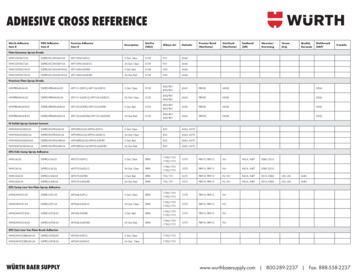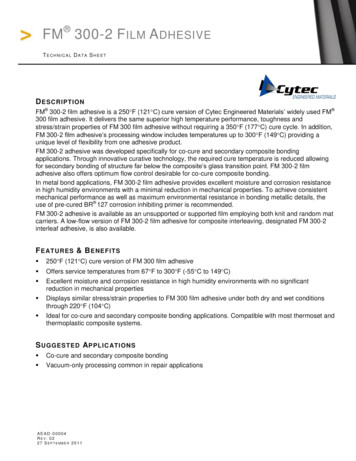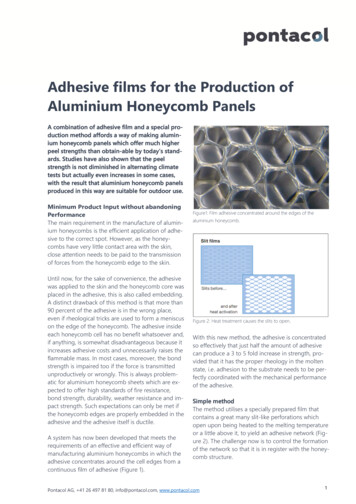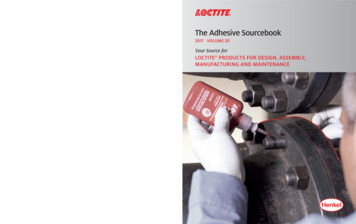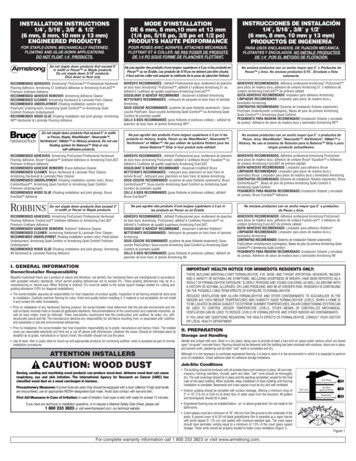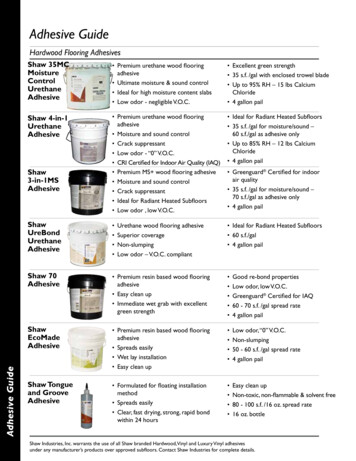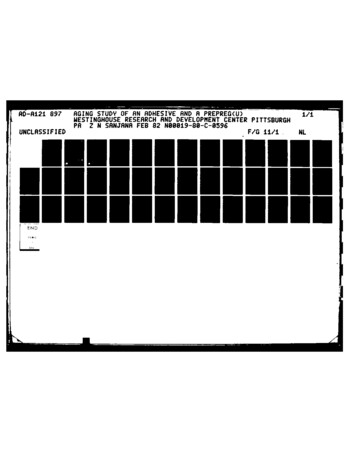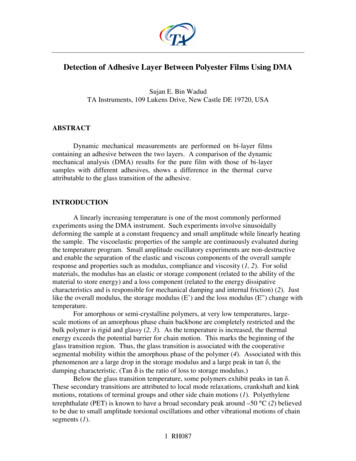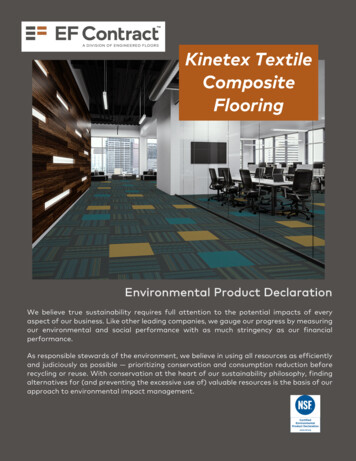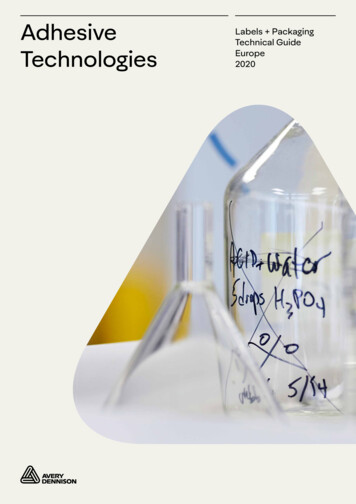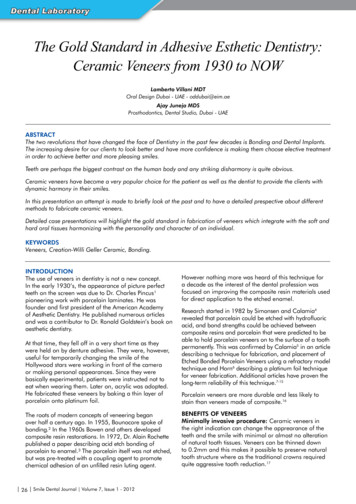
Transcription
The Gold Standard in Adhesive Esthetic Dentistry:Ceramic Veneers from 1930 to NOWLamberto Villani MDTOral Design Dubai - UAE - oddubai@eim.aeAjay Juneja MDSProsthodontics, Dental Studio, Dubai - UAEABSTRACTThe two revolutions that have changed the face of Dentistry in the past few decades is Bonding and Dental Implants.The increasing desire for our clients to look better and have more confidence is making them choose elective treatmentin order to achieve better and more pleasing smiles.Teeth are perhaps the biggest contrast on the human body and any striking disharmony is quite obvious.Ceramic veneers have become a very popular choice for the patient as well as the dentist to provide the clients withdynamic harmony in their smiles.In this presentation an attempt is made to briefly look at the past and to have a detailed prespective about differentmethods to fabricate ceramic veneers.Detailed case presentations will highlight the gold standard in fabrication of veneers which integrate with the soft andhard oral tissues harmonizing with the personality and character of an individual.KEYWORDSVeneers, Creation-Willi Geller Ceramic, Bonding.INTRODUCTIONThe use of veneers in dentistry is not a new concept.In the early 1930’s, the appearance of picture perfectteeth on the screen was due to Dr. Charles Pincus¹pioneering work with porcelain laminates. He wasfounder and first president of the American Academyof Aesthetic Dentistry. He published numerous articlesand was a contributor to Dr. Ronald Goldstein’s book onaesthetic dentistry.At that time, they fell off in a very short time as theywere held on by denture adhesive. They were, however,useful for temporarily changing the smile of theHollywood stars were working in front of the cameraor making personal appearances. Since they werebasically experimental, patients were instructed not toeat when wearing them. Later on, acrylic was adopted.He fabricated these veneers by baking a thin layer ofporcelain onto platinum foil.The roots of modern concepts of veneering beganover half a century ago. In 1955, Bounocore spoke ofbonding.² In the 1960s Bowen and others developedcomposite resin restorations. In 1972, Dr. Alain Rochettepublished a paper describing acid etch bonding ofporcelain to enamel.³ The porcelain itself was not etched,but was pre-treated with a coupling agent to promotechemical adhesion of an unfilled resin luting agent. 26 Smile Dental Journal Volume 7, Issue 1 - 2012However nothing more was heard of this technique fora decade as the interest of the dental profession wasfocused on improving the composite resin materials usedfor direct application to the etched enamel.Research started in 1982 by Simonsen and Calamia4revealed that porcelain could be etched with hydrofluoricacid, and bond strengths could be achieved betweencomposite resins and porcelain that were predicted to beable to hold porcelain veneers on to the surface of a toothpermanently. This was confirmed by Calamia5 in an articledescribing a technique for fabrication, and placement ofEtched Bonded Porcelain Veneers using a refractory modeltechnique and Horn6 describing a platinum foil techniquefor veneer fabrication. Additional articles have proven thelong-term reliability of this technique.7-15Porcelain veneers are more durable and less likely tostain than veneers made of composite.16BENEFITS OF VENEERSMinimally invasive procedure: Ceramic veneers inthe right indication can change the apprearance of theteeth and the smile with minimal or almost no alterationof natural tooth tissues. Veneers can be thinned downto 0.2mm and this makes it possible to preserve naturaltooth structure where as the traditional crowns requiredquite aggressive tooth reduction.17
Excellent Biological Response: Ceramic as a materialis known to have the best biologial response around it. Itis a crystalline glass and has minimal or no tendency toget scratched or have surface alterations over the years,thereby keeping the colour and tissue integrity over theyears.18,19An increase in crevicular fluid: It is known to stimulatethe gingival tissue and improve circulation around wellfitting margins. This leads to an increase in crevicularfluid, which in turn leads to less plaque retention.20Natural fluorescence: Under exposure to ultraviolet,natural teeth emit a light blue fluorescence which alsoenhances the whiteness and brightness of teeth indaylight. Different chemical activators are added incommercial dental ceramics to present the fluorescencewhich can act as natural teeth in color and intensityunder exposure of sunlight or artificial ultravioletillumination. Over the years ceramics have beendeveloped for them to have natural fluorescence tomimic the optical properties of the Dentine. If this is notpresent in a restorative material then the restorations canlook lifeless in certain light conditions.²¹INDICATIONS Diastemas closure Tetracycline discoloration Crowded teeth Fractured teeth Gummy smile To change the shape of the teeth e.g: MicrodontiaCONTRAINDICATIONS Deep bite Less than 50% of the bonding surface is enamel Patients with known history of parafunction and havingdamaged similar restorations in the past Highly Flourosed teethDIFFERENT SYSTEMSCast glass-ceramic (Dicor)The Dicor crown system uses the lost wax system toproduce a glass casting of the restoration. Were firstintroduced for all-ceramic crowns. The material exhibitsinteresting physical and chemical properties, but the highfabrication costs and restricted esthetics have limitedfurther development of this system.(Fig. 1)Pressed Ceramic (Empress, Impulse, Creation etc.)Offers two elaboration modalities:The reinforced pressed porcelain is used to fabricateeither an entire restoration or only a core. This latteroption allows esthetic improvements and characterizationby additional ceramic firing. Esthetic characterization,however, remains very limited compared to the fullthickness layering that can be applied with the refractorydie technique.Slip casting (In-Ceram Spinell)Can generate restorations with higher intrinsic strengthcompared to other systems. The basic method wasoriginally marketed for full crowns and later adapted toveneers with the use of spinel instead of alumina. Dueto the high crystalline content of this material, traditionalhydrofluoric acid etching is not effective. Resin bonding toIn-Ceram alumina, for instance, requires tribochemicalsilica coating or use of a special resin monomer.Machined ceramic (Cerec)Even though originally designed for chairside use, havebecome popular laboratory use also. Veneers made frommachined ceramic suffer from shade uniformity andrather simplistic anatomy, unless additional porcelainfirings are carried out.Refractory die techniqueCeramic fired over refractory die is the oldest and themost widespread method for fabricating a porcelainobject. The main advantages of this technique are: No special equipment required Extremely sophisticated effects of color andtranslucency can be obtained through a full-thicknesslayering technique Traditional feldsphatic porcelains can be used whencombined with hydrofluoric acid etching and silanization,they show extremely reliable bonding to resins Marginal closure from 20 to 40 mµ²²CASE 1 Courtesy of Dr. Rabih Abi NaderThis is a case where the patient was unhappy with theshape and colour of her teeth. (Fig 1)After critical evaluation it was planned that 4 veneers forteeth 22, 21, 11 and 12 should be a good treatmentoption. The midline was also corrected to be more in linewith the midline of the face. (Fig 2)(Fig. 2)Smile Dental Journal Volume 7, Issue 1 - 2012 27
Refractory Die technique was used with gingival model(Willi Geller model) with accurate gingival contours andartificial alveoli conforming to the original shape ofthe dies. The major advantage of this soft tissue cast isthat stone dies and refractory dies can be inserted andinterchanged, due to the identical design of their rootportions , which have the same antirotation grooves. (Fig 3)The ceramic build-up was made with the application ofdentin powders using the base shade dentin and severalshades with higher chroma in the cervical area andhigher value in the incisal area. (Creation Ceamic)CASE 2 Courtesy of Dr. Jaco Smith28 years old female patient complaining about her frontteeth. (Fig 4)All four upper anteriors had old composite fillings andthere was crowding (Fig 5). Looking at her face theactual shape of the teeth were not in harmony with herface. There was a defianate negative space between herBeforeAfter(Fig. 4)(Fig. 10)(Fig. 3)teeth and her lips which was in the acceptable range,but it was decided to increase the legnth of the centralincisors by approximately 1mm. A more oval shape ofher teeth was better suited to her face and lips. (Fig 6,7)Four porcelain veneers were cemented on central andlateral incisors. (Fig 8-10)(Fig. 5)(Fig. 6)(Fig. 7)(Fig. 8)(Fig. 9) 28 Smile Dental Journal Volume 7, Issue 1 - 2012
CASE 3 Courtesy of Dr. Ajay Juneja26 years old male patient complaining about his teethhaving diastems and desiring a lighter shade. (Fig 11,12)The lateral incisors were narrow and rounded, havingBefore(Fig. 11)a rather feminine appearance. It was decided to dofour veneers on teeth 22,21,11 and 12 to eliminate thediastema and to make the smile more masculine bymaking the laterals slightly broader. (Fig 13-15)After(Fig. 15)CASE 4 Courtesy of Dr. Ajay JunejaA 34 year old healthy female came to the dentist’s officewith aesthetic concerns and wanted to have a moreconfident smile (Fig 16). The case was referred to the labfor preoperative evaluation. The patient had concernsabout the esthetics of her front teeth which had receivedtreatment earlier.(Fig. 12)Diagnosis:Taking into consideration the patient’s expectations andalso clinical examination the following diagnosis wasmade:BeforeAfter(Fig. 16)(Fig. 23)(Fig. 13)(Fig. 14)(Fig. 17)Smile Dental Journal Volume 7, Issue 1 - 2012 29
(Fig. 18)(Fig. 22) Patient was called to the lab to review wax up and wasshown the same for her approval Shade selection was done in the laboratory at thisstage Preparation guides were made to assist the clinician inideal tooth reduction for the case (Fig. 18)(Fig. 19)The Laboratory work was then sent to the Dentist forcementation.The veneers were cemented following a standardprotocol of Bonding and were polished thereafter.The patient made a follow up appointment at thelaboratory where the final pictures were made. (Fig 1923)(Fig. 20)DISCUSSIONCeramic veneers which are fabricated using a layeringtechnique with all protocols being followed duringthe course of treatment offer patients a very naturaland esthetic result. We are able to achieve a bettermarginal closing with veneers made with refractory dietechnique.Feldspathic ceramic remains the best material to attainnatural looking shade when compared to any other ceramic.(Fig. 21)Medium to long-term clinical investigations havedemonstrated excellent maintenance of esthetics, highpatient satisfaction and absence of adverse effects ongingival health.REFERENCESThe patient had four composite anterior veneers donewhich lacked form, shade and texture. (Fig. 17)1. There was history of these getting discolored veryrapidly and she was having to get them cleaned timeand again2. There was some sensitivity to cold on tooth no. 22which had a restoration extending interproximally1.Treatment Provided: All relevant photographs were taken After receiving study models a wax up was done for11,12,21,224. 30 Smile Dental Journal Volume 7, Issue 1 - 2012Pincus CL.”Building mouth personality” A paper presented at:California State Dental Association. 1937:San Jose, California.2.Buonocore M. A simple method of increasing the adhesionof acrylic filling materials to enamel surfaces. J Dent Res.1955;34(6):849-53.3.Rochette, A:A ceramic restoration bonded by etched enamel andresin for fractured incisors. J Prosth Dent. 1975;33(3):287-93.Simonsen R.J. and Calamia John R. “Tensile Bond Strengths ofEtched Porcelain”, Journal of Dental Research, Vol. 62, March1983, Abstract #1099.
5.Calamia John R. “Etched Porcelain Facial Veneers: ANew Treatment Modality Based on Scientific and ClinicalEvidence”, New York Journal of Dentistry.1983;53(6):255-9.6.Horn HR. “A new lamination, porcelain bonded to enamel”.NY St Dent J. 1983;49(6):401-3.7.Calamia John R. and Simonsen R.J. “Effect of CouplingAgents on Bond Strength of Etched Porcelain”, Journal ofDental Research. Vol. 63, March 1984, Abstract #79.8.Calamia John R. “Etched Porcelain Veneers: The CurrentState of the Art”, Quintessence International, Vol. 16 #1,January 1985.9.Quinn F Mc Connell RJ “Porcelain Laminates: A review”, BrDental J. 1986:161(2):61-5.10. Calamia John R. “Clinical evaluation of etched porcelainveneers” Am J Den. 1989:2:9-15.11. Nathanson D, Strassler HE. Clinical evaluation of etchedporcelain veneers over a period of 18 to 42 months J EsthetDent. 1989;1(1):21-28.12. Strassler HE, Weiner S “Long-term clinical evaluation ofetched porcelain veneers” J Dental Res. 77 (Special IssueA):233 Abstract 1017,1998.13. Friedman, MJ “A 15-year review of porcelain veneer failurea clinicians’ observations. Compend Contin Educ Dent.1998;19(6):625-36.14. Calamia John R. “Etched Porcelain Laminate Restorations:A 20-year Retrospective- Part 1” AACD Monograph. Vol II2005;137-145 Montage Media Publishing.15. Barghi, N , Overton JD “Preserving Principles of SuccessfulPorcelain Veneers” Contempory Esthetics 2007:11(1)48-51.16. Calamia John R.,Calamia Christine S. Porcelain LaminateVeneers: Reasons for 25 Years of Success, Successful Estheticand Cosmetic Dentistry for the Modern Dental Practice,Dental Clinics of North America. April 2007 Vol 51 No. 2.17. Galip Gurel Science and Art of Porcelain Laminate Veneers.18. S. Kourkouta, T. T. Walsh, L. G. Davis The effect of porcelainlaminate veneers on gingival health and bacterial plaquecharacteristics Article first published online: 13 DEC 2005DOI: 10.1111/j.1600-051X.1994.tb00756.19. Lamberto Villani. Biomimetic Ceramic Veneers: a SuccessfulTeam Concept. Smile Dental Journal. 2010;Vol.5,Issue 4.20. DJ Pippin, JM Mixson, and AP Soldan-Els Clinical evaluationof restored maxillary incisors: veneers vs. PFM crownsJournal of the American Dental Association, Vol 126, Issue11, 1523-1529.21. Monsénégo G, Burdairon G, Clerjaud B. Fluorescence ofdental porcelain. J Prosthet Dent. 1993 Jan;69(1):106-13.Faculty of Dental Surgery, Rene Descartes University, Paris,France.22. Pascal Magne, Michel Magne, Urs Belser Bonded PorcelainRestorations in the Anterior Dentition.Smile Dental Journal Volume 7, Issue 1 - 2012 31
Porcelain veneers are more durable and less likely to stain than veneers made of composite.16 BENEFITS OF VENEERS Minimally invasive procedure: Ceramic veneers in the right indication can change the apprearance of the teeth and the smile with minimal or almost no alteration of natural tooth tissues. Veneers can be thinned down


